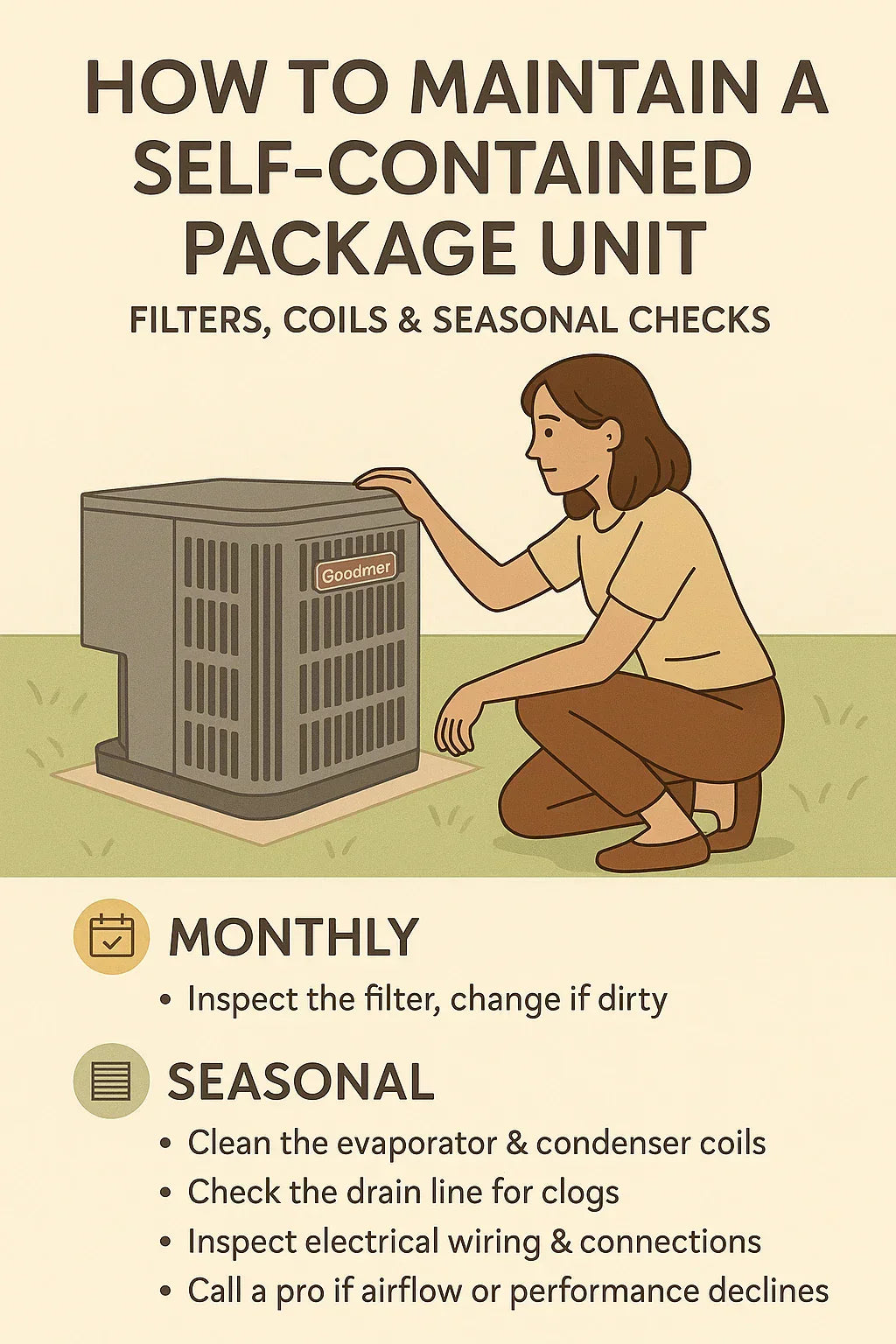A self-contained HVAC package unit, like the Goodman 2.5 Ton 13.4 SEER2 Horizontal Package AC, houses all its components in a single outdoor cabinet. That makes maintenance easier in some ways, but also more important due to constant exposure to the elements.
If you want to keep your system running efficiently and extend its lifespan, routine maintenance is a must. This guide walks Savvy homeowners through everything you need to know—month-by-month.
🌟 Why Package Unit Maintenance Is So Important
Unlike split systems where the air handler is protected indoors, package units endure rain, snow, debris, and UV all year round. Neglecting routine care leads to:
-
Reduced efficiency and SEER2 performance
-
Dirty coils and poor airflow
-
Early compressor failure
-
Water drainage issues
🔗 Reference: ENERGY STAR HVAC Maintenance Tips
🗓️ Monthly & Seasonal Maintenance Overview
📅 Monthly:
-
Check and clean air filter
-
Inspect for debris, leaves, nests near unit
-
Listen for unusual sounds
🌸 Spring:
-
Clean outdoor coils
-
Test thermostat
-
Clear condensate drain
-
Turn system to cool and observe operation
🍂 Fall:
-
Test heat mode (heat pump or electric strip)
-
Check burner/flue (gas combo units)
-
Cover unit (if manufacturer approved)
🪑 Replacing or Cleaning Your Air Filter
Where is it?
-
Located inside the return air section of the package unit
How often?
-
Every 30–60 days depending on dust/pet level
What type?
-
Washable or disposable (check your model specs)
Why it matters:
-
Dirty filters cause airflow restrictions and reduce SEER2 performance
💨 How to Clean Your Coils
Which coils?
-
Condenser Coil: outside of unit, visible from exterior vents
-
Evaporator Coil: internal, best cleaned by a pro
Steps to clean condenser coil:
-
Turn off power at disconnect box
-
Remove side panel or protective grille
-
Use a soft brush to remove visible debris
-
Spray coil cleaner and rinse gently with a garden hose
🔗 Tool Tip: Home Depot Coil Cleaning How-To
💧 Check and Clear the Drainage System
Condensate buildup can lead to mold and water damage if not properly drained.
Checklist:
-
Look for standing water in or near the drain pan
-
Pour 1 cup vinegar or bleach into the drain line every 3 months
-
Use shop vac on the outlet if clogged
Why it matters: A blocked drain can trigger float switches or cause internal flooding.
🔋 Inspecting Electrical & Refrigerant Components
What to check visually:
-
Frayed or corroded wiring
-
Burnt or bulging capacitors
-
Loose terminal screws
-
Ice on refrigerant lines = potential low charge
Important: Do not open refrigerant loops or test capacitors unless certified. Call an HVAC tech for:
-
Refrigerant pressure testing
-
Capacitor microfarad measurements
-
Electrical load balancing
🌺 Seasonal Prep: Spring Start-Up & Fall Shutdown
🌸 Spring Start-Up:
-
Clear all leaves, mulch, and cover (if used)
-
Power on the system and switch to COOL mode
-
Test thermostat accuracy
-
Confirm outdoor fan starts smoothly
-
Listen for vibration or unusual noises
🍂 Fall Shutdown (or HEAT prep):
-
Switch system to HEAT mode
-
Test electric heat strips or gas burners
-
Smell test: brief “burnt dust” smell normal
-
Cover top of unit with breathable cover (optional)
❌ Common Mistakes to Avoid
-
Using wrong-size or MERV filter
-
Powering on AC with a dirty coil or clogged drain
-
Covering unit with plastic tarp (no airflow = mold)
-
Ignoring short-cycling (system turns on/off rapidly)
-
Skipping annual professional inspection
💼 When to Call a Pro
While Savvy homeowners can handle a lot of maintenance, some jobs need a technician:
-
Annual tune-up (spring or fall)
-
Refrigerant diagnostics or refill
-
Blower motor or capacitor replacements
-
Duct sealing or balancing
What a tech typically checks:
-
Refrigerant levels
-
Voltage/amperage draw
-
Airflow in supply/return ducts
-
Electrical resistance on heat strips or coils
Cost Range: $150–$300 depending on service and region
🗓️ Savvy Maintenance Calendar (By Month)
| Month | Task |
|---|---|
| January | Check filter, test HEAT |
| March | Clear debris, clean coils |
| May | Flush drain line, switch to COOL |
| July | Check filter, listen for vibration |
| September | Inspect wiring, test heat mode |
| November | Schedule pro tune-up |
🚀 Final Tip: Maintenance = Efficiency + Longevity
A little regular attention goes a long way. Keeping your Goodman package unit clean, clear, and serviced ensures:
-
Lower utility bills
-
Cleaner indoor air
-
Less emergency service
-
10–20 years of reliable comfort
For more DIY tips and sizing help, browse the rest of our Savvy HVAC Maintenance Series.
In the next topic we will read about: Can a Horizontal Package Unit Cool a Multi-Zone Home? Smart Ducting Solutions







